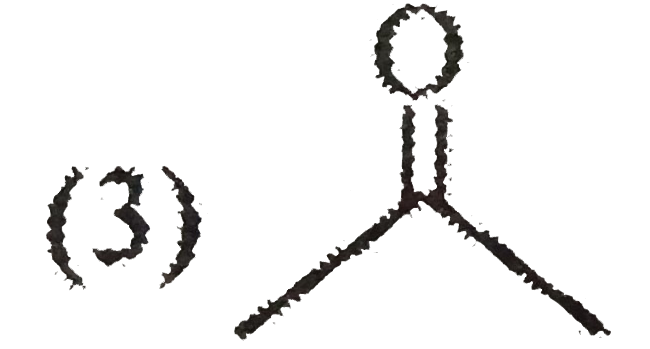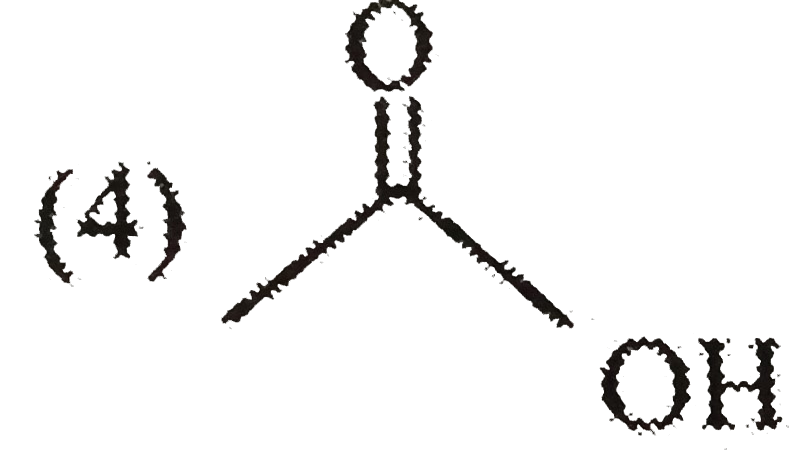CH3−CH2−O∣∣C−OAgBr2−−→CCl4X(1) Li−−−→(2) CuIYCH3−CH2−Br−−−−−−−−−→dry etherZ
CH3−CH3
CH3−CH2−CH3
CH3−cH2−CH2−CH3
CH3−CH3| CH−CH3.
The correct Answer is:C
To solve the given reaction sequence step by step, let's break down each part of the process:
Step 1: Reaction of Silver Salt of Carboxylic Acid with Bromine
The starting compound is a silver salt of a carboxylic acid, which can be represented as CH₃-CH₂-C(=O)OAg. When this compound reacts with Br₂ in the presence of CCl₄, it undergoes a reaction known as the Hunsdiecker reaction.
Reaction:
CH3CH2C(=O)OAg+Br2CCl4−−−→CH3CH2C(=O)Br+CO2+AgBr
Product: The product formed here is CH₃-CH₂-C(=O)Br, and carbon dioxide (CO₂) is released.
Step 2: Free Radical Mechanism
In the presence of bromine, the reaction proceeds via a free radical mechanism. The bromine attacks the carbonyl carbon, leading to the formation of a radical:
1. The bromine adds to the carbonyl carbon, forming a brominated intermediate.
2. The bond between the carbon and the bromine breaks, leading to the formation of a radical and the release of CO₂.
Step 3: Formation of Alkyl Bromide (X)
The radical formed (CH₃-CH₂•) can then combine with Br• to form the alkyl bromide:
Product:
CH3CH2Br
This compound is denoted as X.
Step 4: Reaction with Lithium
Next, we treat the alkyl bromide (X) with lithium (Li):
Reaction:
CH3CH2Br+Li→CH3CH2Li+LiBr
Product: The product formed is CH₃-CH₂-Li, which is denoted as Y.
Step 5: Reaction with Copper(I) Iodide (CuI)
Now, we react the lithium alkyl (Y) with copper(I) iodide:
Reaction:
CH3CH2Li+CuI→CH3CH2Cu+LiI
Product: The product formed is CH₃-CH₂-Cu, which is still denoted as Y.
Step 6: Reaction with Alkyl Bromide
Finally, we react Y with another molecule of alkyl bromide (CH₃-CH₂-Br) in dry ether:
Reaction:
CH3CH2Cu+CH3CH2Br→CH3CH2CH3+CuBr
Product: The product formed is butane (CH₃-CH₂-CH₂-CH₃), which is denoted as Z.
Final Summary
- The final product Z is butane (C₄H₁₀).
The starting compound is a silver salt of a carboxylic acid, which can be represented as CH₃-CH₂-C(=O)OAg. When this compound reacts with Br₂ in the presence of CCl₄, it undergoes a reaction known as the Hunsdiecker reaction.
CH3CH2C(=O)OAg+Br2CCl4−−−→CH3CH2C(=O)Br+CO2+AgBr
In the presence of bromine, the reaction proceeds via a free radical mechanism. The bromine attacks the carbonyl carbon, leading to the formation of a radical:
2. The bond between the carbon and the bromine breaks, leading to the formation of a radical and the release of CO₂.
The radical formed (CH₃-CH₂•) can then combine with Br• to form the alkyl bromide:
CH3CH2Br
This compound is denoted as X.
Next, we treat the alkyl bromide (X) with lithium (Li):
CH3CH2Br+Li→CH3CH2Li+LiBr
Now, we react the lithium alkyl (Y) with copper(I) iodide:
CH3CH2Li+CuI→CH3CH2Cu+LiI
Finally, we react Y with another molecule of alkyl bromide (CH₃-CH₂-Br) in dry ether:
CH3CH2Cu+CH3CH2Br→CH3CH2CH3+CuBr
- The final product Z is butane (C₄H₁₀).
Topper's Solved these Questions
Similar Questions
Knowledge Check
- Question 1 - Select One
CH_3-CH_2- overset(O) overset(||) C-O Ag overset(Br_2)underset(C Cl_4) to X ((1)Li)/((2) CuI) X overset(CH_3-CH_2-Br) underset(शुष्क ईथर)to Z
ACH3−CH3BCH3−CH2−CH3CCH3−CH2−CH2−CH3DCH3−CH3∣CH−CH3 - Question 2 - Select One
CH3−O∣∣C−OHND3−−−−−→Δ(A)Br2−−−−−→KOH(B)
Product (B) is -ACH3−ND2BCH3−NH2C D
D
- Question 3 - Select One
H3C−CH2−CH3∣CH−C∣∣O−NH2Br2+KOH−−−−−−→ΔA1.CH3I(excess)−−−−−−−−−→2.AgOH,ΔB The major product (B) is:
ACH3−CH2−CH=CH2B CH3C−CH=CH−CH3D
CH3C−CH=CH−CH3D
What is compound Z?
CH3CH2CH2BrNaCN−−−→XH3O+−−−→heatYCH3CH2OH−−−−−−−→H+ZView SolutionCH3−C≡C−CH3H2−−−−−−→Pd−BaSO4
(A) Br2−−→CCl4(B)View SolutionCH3CH3∣C∣CH3−Br KOH (alcoholic) −−−−−−−−−−−−→Δ(A)HBr/R2O2−−−−−−→(B)(major)
(B) isView SolutionCH3−CH3∣C∣OH−CH3∣C∣NH2−CH3HNO2−−−→Δ?
View SolutionCH3−(CH2)3−OHCH3−O∣∣S∣∣O−Cl−−−−−−−−−→ET3N(A)14KCN−−−−−→(B)H3O⊕−−−→(C)
Product (C) is :View Solution

